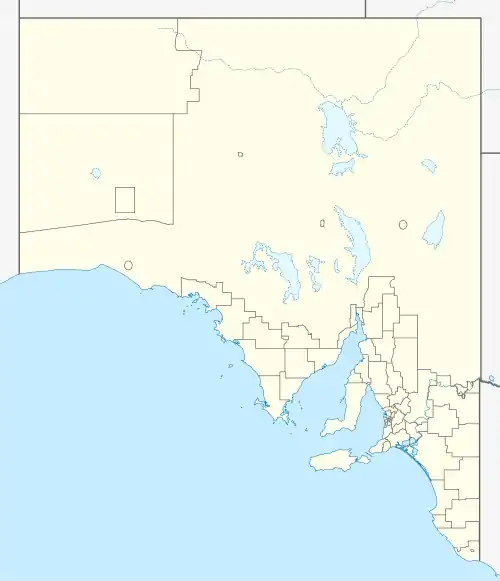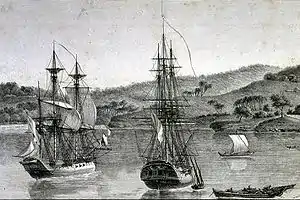 Veteran Isles | |
| Geography | |
|---|---|
| Location | Great Australian Bight |
| Coordinates | 33°44′34″S 134°17′05″E / 33.742752°S 134.284829°E |
| Area | 14 ha (35 acres)[1] |
| Highest elevation | 82 m (269 ft)[1] |
| Administration | |
Veteran Isles (French: Ile du Veteran; also known as the Veteran Islands) is a pair of islands in the Australian state of South Australia which is part of the Pearson Isles which itself is part of the larger island group known as the Investigator Group. It is located about 69 kilometres (43 miles) west south-west of Cape Finniss on the west coast of Eyre Peninsula. It was discovered as part of the Pearson Isles by Matthew Flinders on 13 February 1802. The island was given its name in August 1969 in order to preserve a name used within the locality by the Baudin expedition. The island has enjoyed protected area status since at least 1972 and since 2011, it been part of the Investigator Group Wilderness Protection Area.
Description
Veteran Isles is a pair of peaks located about 1 kilometre (0.62 miles) south of Pearson Island and about 0.5 kilometres (0.31 miles) apart. The northern island rises to a height of 82 metres (269 feet) above sea level while the south island reaches a height of 25–26 metres (82–85 feet). One source reports a combined area of 14 hectares (35 acres) for both islands. The northern island “retains pockets of granitic soil’ that supports a shrubland on its upper levels while southern island is bare of soil and therefore vegetation due to wave action. As 1996, access via boat was suggested as being “hazardous” due to the combination of a steep shoreline and sea conditions that need to be calm.[1][2]
Formation, geology and oceanography
The Veteran Isles were formed along with the rest of the Pearson Isles about 10,500 years ago following the rise of sea levels at the start of the Holocene.[3] Geologically, the Veteran Isles and the other parts of the Pearson Isles are the summits of an inselberg partially concealed by sea level rise.[4] The waters adjoining Veteran Isles are shown on Admiralty Charts as falling immediately to depths equal and greater than 50 metres (160 feet) from the Isles' shoreline.[2]
Flora and fauna
Flora
As of 1996, the north island supported low shrublands dominated respectively by two species - marsh saltbush and twiggy daisy-bush. As of 1996, the southern island was reported as being bare of soil and vegetation presumably due to being washed away by swells breaking over the island.[1][5][6]
Fauna
Vertebrate animals observed on both islands consist of mammals, birds and reptiles. The northern island has been observed in 1980 as being used as a haul out both by Australian sea lions and New Zealand fur seals, although a survey conducted in 2014 found no fur seals to be present. Bird species which are considered to be residents include sooty oystercatcher, little penguin and rock parrot while species observed on the island such as Cape Barren geese are considered to be visitors. Reptiles are represented by the marbled gecko, the four-toed earless skink and the peninsula dragon.[1][7] The southern island has been observed as being used as a haul out by New Zealand fur seals, although a survey conducted in 2014 revealed the possible use of the island as a breeding site. Other species observed on the island in 1980 and which are considered to be visiting include Australian sea lion, sooty oystercatcher and Pacific gull.[1][8][9]
History
European discovery
Veteran Isles is part of the island group sighted by Matthew Flinders on Saturday, 13 February 1802 and who subsequently named the group as the Pearson Isles on the same day.[10]
Nomenclature
The pair of islands was officially named in August 1969 by the South Australian government as the “Veteran Isles”, being the anglicised version of “Iles du Veteran”, in response to the following recommendation made by the Nomenclature Committee in 1965 within the then Department of Lands:[11][12]
The Committee recommends the adoption of the names "Veteran Isles" for the two small islands in the Pearson Islands and "Dorothee Island" for the southernmost island in this group. It is with some reservations that the Committee makes this recommendation as these names were first used on the chart of Captain Baudin's voyage prepared by F Peron and L de Freycinet and difficulty is experienced in relating islands shown in this chart to present day Admiralty Charts but as these names do not appear on modern charts this recommendation is a means of perpetuating them in the general area of the first use'.
Protected areas status
The Veteran Isles are first mentioned as specifically receiving protected area status in 1972 as part of the Investigator Group Conservation Park proclaimed under the National Parks and Wildlife Act 1972 for the purpose of protecting “delicate island ecology and Australian sea lion and New Zealand fur seal haul-out areas”. On 25 August 2011, it was one of the islands excised from the Investigator Group Conservation Park to form the Investigator Group Wilderness Protection Area.[13][14][15] Since 2012, the waters adjoining Veteran Isles have been part of a sanctuary zone in the Investigator Marine Park.[16]
See also
Citations
- 1 2 3 4 5 6 Robinson et al, 1996, page 200
- 1 2 RAN, 1979
- ↑ Robinson et al, 1996, Pages 11 & 13
- ↑ Robinson et al, 1996, page 196
- ↑ DEH, 2006, page 19
- ↑ Robinson et al, 1996, page 480
- ↑ Shaughnessy et al, 2014, page 12
- ↑ Robinson et al, 1996, pages 383 & 388
- ↑ Shaughnessy et al, 2014, page 31
- ↑ Flinders, 1814 (1966), page 223
- ↑ Manning, 2006, pages 131 & 435
- ↑ RSSA, 1971, page 121
- ↑ Robinson et al, 1996, page 145
- ↑ DEH, 2006, page 6
- ↑ WAC, 2013, pages 16-17
- ↑ DEWNR, 2012, page 22 of 26
References
- Anon (2006). Island Parks of Western Eyre Peninsula Management Plan (PDF). Adelaide: Department for Environment and Heritage (DEH), South Australia. ISBN 1-921238-18-6.
- Investigator Marine Park Management Plan 2012 (PDF). Department for Environment Water and Natural Resources (DEWNR). 2012.
- Flinders, Matthew (1966) [1814]. A Voyage to Terra Australis : undertaken for the purpose of completing the discovery of that vast country, and prosecuted in the years 1801, 1802, and 1803 in His Majesty's ship the Investigator, and subsequently in the armed vessel Porpoise and Cumberland Schooner; with an account of the shipwreck of the Porpoise, arrival of the Cumberland at Mauritius, and imprisonment of the commander during six years and a half in that island (Facsimile ed.). Adelaide: Libraries Board of South Australia. Retrieved 20 April 2015.
- Manning, Geoffrey H (2006), Manning's place names of South Australia from Aaron Creek to Zion Hill ([Extended and rev. ed.] ed.), Gould Books, ISBN 978-0-947284-60-2
- A.C., Robinson; Canty, P.; Mooney, T.; Rudduck, P. (1996). South Australia's offshore islands (PDF). Canberra: Australian Heritage Commission. ISBN 0-644350-11-3.
- "Pearson Island Expedition 1969". Transactions of the Royal Society of South Australia. Adelaide: Royal Society of South Australia (RSSA). 95 (Part 3): 121–183. 15 October 1971. Retrieved 10 January 2015.
- "Wilderness Advisory Committee Annual Report 2012-13 (WAC)" (PDF). Annual Report. Department for Environment Water and Natural Resources: 16–17. September 2013. ISSN 1832-9357. Retrieved 17 March 2014.
- Shaughnessy, P.D.; Goldsworthy, S.D.; Mackay, A.I. (June 2014). Status and trends in abundance of New Zealand fur seal populations in South Australia. Final report to the Australian Marine Mammal Centre. SARDI Publication No. F2014/000338-1. SARDI Research Report Series No. 781 (PDF). Adelaide: South Australian Research and Development Institute (Aquatic Sciences). Retrieved 20 April 2015.
